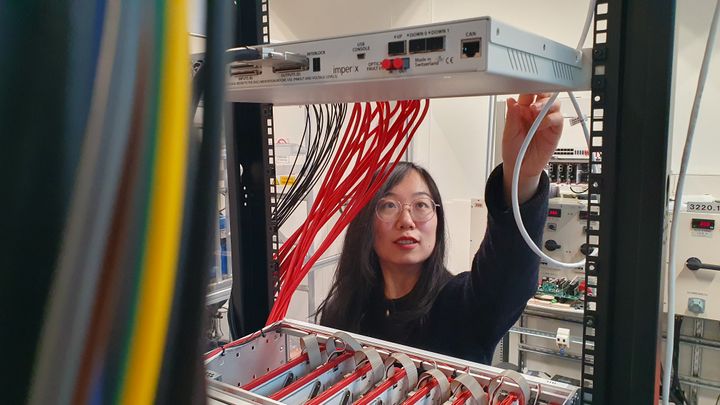AI protects power grid from fluctuations caused by renewables and EVs
In order to prevent power grid failure in a society where electrification is supplied increasingly by variable sources like solar and wind, researchers in Sweden report the development of artificial intelligence algorithms intended to react swiftly when the network’s voltage balance is threatened.

They may be better for the planet but when combined, renewable energy and electric vehicles may also destabilize power grids, setting in motion a range of problems from malfunctioning laptops to regional blackouts. That’s because random variations in supply and demand place pressure on the network’s capacity to maintain a steady voltage level.
It’s this pressure that an open-source AI solution was developed to address, says Qianwen Xu, a researcher at KTH Royal Institute of Technology in Stockholm.
“Wind power and solar radiation are not consistent from hour to hour,” Xu says. “And demand for charging EVs is based on people’s personal needs and habits. So, you have a high level of stochastics and uncertainties. Their integration will lead to voltage fluctuations, deviations and even voltage security violation challenges.”
The new open-source deep reinforced learning (DRL) algorithms are designed to solve this challenge by delivering intelligence for power converters deep in the grid, where they optimize large-scale coordination of energy sources safely under fast fluctuations without real-time communication, she says. The DRL provides a novel data synchronization strategy to deal with communication delay for data driven algorithms.
“Centralized control is not cost-efficient or fast under continuous fluctuations of renewable energy and electric vehicles,” she says. “Our aim is an AI-based self control for each distributed energy source, which are interfaced by power converters.”
The researchers demonstrated it in a real-world smart microgrid hardware platform at KTH. The open-source software package is published in Github, and the research paper is reported in the journal IEEE Transactions on Sustainable Energy.
The solution’s decentralized management approach would maintain voltage levels within certain required limits. Beyond that margin voltage fluctuations would risk a detrimental effect on the performance of electrical equipment as well as on the overall stability of the grid, Xu says.
Voltage deviations can lead to the inefficient operation of electrical devices, reduce their lifespan, and in extreme cases, cause damage to the grid infrastructure. More alarmingly, voltage security violations can lead to blackouts or the need for emergency interventions, such as load shedding or the use of reserve generators, to maintain grid stability, she says.
“Our purpose is to improve control strategies for power converters, by making them more adaptive and intelligent in order to stabilize complex and changing power grids,” Xu says.
This work is part of Digital Futures, a KTH-based research center that explores and develops digital technologies, along with researchers from University of California, Berkeley and Stockholm University.
Read the research paper:
Data Driven Decentralized Control of Inverter based Renewable Energy Sources using Safe Guaranteed Multi-Agent Deep Reinforcement Learning, IEEE Transactions on Sustainable Energy, DOI: https://doi.org/10.1109/TSTE.2023.3341632
Subscribe to releases from KTH Royal Institute of Technology
Subscribe to all the latest releases from KTH Royal Institute of Technology by registering your e-mail address below. You can unsubscribe at any time.
Latest releases from KTH Royal Institute of Technology
AI helps decode horses' body language for better veterinary care9.4.2025 12:20:55 CEST | Press Release
Researchers are using AI to bridge the communication gap between horse and human. Combining 3D motion capture and machine learning, a new modeling system would equip veterinarians with a powerful visual tool for interpreting equine body language—the key to detecting physical and even behavioral problems.
New Swedish Initiative to Integrate Research and Healthcare4.4.2025 11:37:56 CEST | Press Release
A groundbreaking national initiative, Precision Omics Initiative Sweden (PROMISE), aims to connect research with healthcare and establish Sweden as a world leader in data-driven precision medicine.
For graphene production, a potential green alternative to mining graphite3.3.2025 14:14:40 CET | Press Release
Researchers in Sweden report a green alternative to reduce reliance on mining graphite, the raw source behind the "wonder material" graphene.
AI on aircraft can help prevent stalls and terrifying drops in altitude17.2.2025 15:58:14 CET | Press Release
Artificial intelligence could help prevent terrifying mid-air drops in altitude. In a new study, an international research team successfully tested a machine learning system for preventing trouble with turbulence.
Alternative to studded winter tires reduces airborne particles by 20 percent6.2.2025 14:41:07 CET | Press Release
On icy roads, studded winter tires can save lives – but they pulverize pavement and fill the air with dangerous, inhalable particles. A new Swedish study shows that both road wear and airborne particles could be reduced by as much as 20 percent if studs were made instead with an alternative hard metal.
In our pressroom you can read all our latest releases, find our press contacts, images, documents and other relevant information about us.
Visit our pressroom